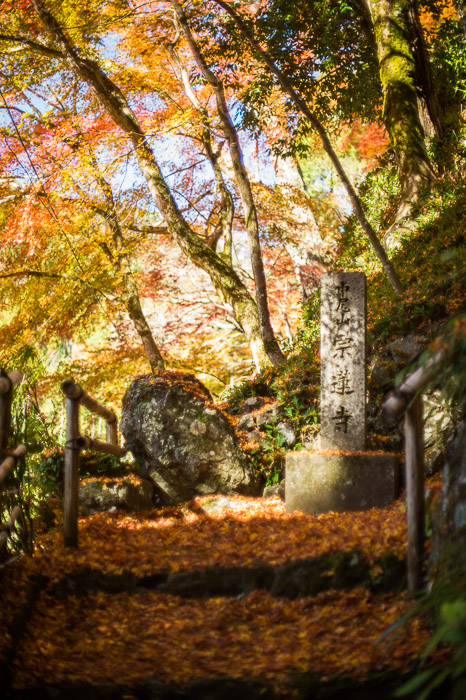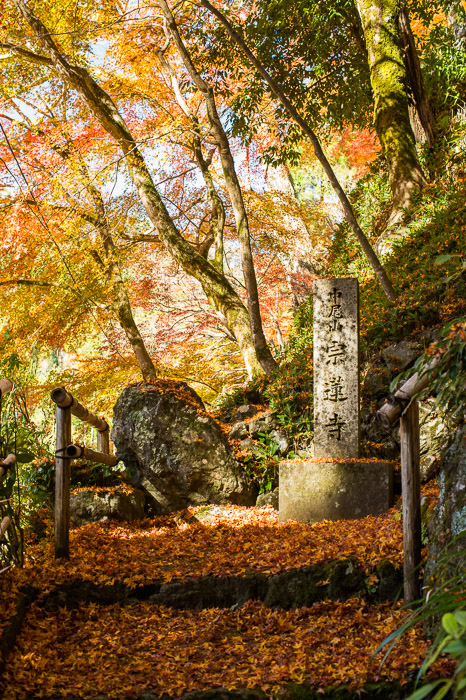
Nikon D4 + Nikkor 50mm f/1.2 — 1/200 sec, f/1.2, ISO 220 — map & image data — nearby photos
Entrance Steps @ f/1.2
at the Sourenji Temple (宗蓮寺), Kyoto Japan
On the outing the other day that produced yesterday's “A Few Pretty Pictures from Kyoto's Middle-of-Nowhere Sourenji Temple” post, I brought along a 50mm f/1.2 lens. I don't use that lens much and need to learn how to use it... my limited experience to date has been chronicled in “Impossible Photography: No Light, No Tripod, No Hope. D700 and a 50mm f/1.2” four years ago, and “Artsy-Fartsy in Kyoto, at f/1.2” five yeas ago.
I'm about to head out this morning for some more fall-foliage photography, but I thought I'd quickly post this pair of shots at different apertures.

Nikon D4 + Nikkor 50mm f/1.2 — 1/200 sec, f/5.6, ISO 3200 — map & image data — nearby photos
Entrance Steps @ f/5.6
This is probably not the situation where one gets much oomph from going super wide. I'll post a few more-appropriate shots another day...
Hi, you should probably change the title to “A quick f/1.2…” instead of “… f/2..”
Kind regards,
Gianluca
Oops, yes, indeed, thanks! —Jeffrey
Sendai, Japan 1953-1956 — Brookville, Ohio current:
Years ago, before color film (Kodak and Fuji) was available, the only people really taking pictures were the Occupation soldiers who had the money and the cameras to take the pictures. I never saw a citizen of Japan with a camera taking pictures — I don’t think they could afford a camera or the film. The new camera stores depended on sales to soldiers to survive. I used to take my rolls of film to a favorite camera store for developing and printing but then began doing it myself in our Signal Corps photo labs. I spent lots of hours doing that after work. Those were the days when the Japanese collected our Olive Green, wool, uniforms and dry cleaned them using aviation fuel. We had to hang them outside on the clothesline to keep them from catching on fire — until they had aired out. My Japan and My Kyoto are totally different from your Japan and your Kyoto. Mine was when a soldier could pay a month’s rent with a pound of coffee or a bar of soap or a tube of toothpaste and a toothbrush. Or, a new leather belt to hold up trousers was a sought after item and replaced many pieces of rope men wore to hold up their trousers that were always too short or too long. Woman wore gatas and clip-clopped along trying to look like a fashion model in a blouse and skirt and nothing fit and high heels were a flop for all of them. It took a long time before one was mistaken in their guess that the lady in high heels was American and discovered to be Japanese in high heels.
I like coming here just to see how far along Japan is nowadays compared to the post war era when toilets on trains still had slits in the floor and human waste spilled out on the railroad tracks below as the trains past. Soldiers were warned not to drink the water or eat the natural food as all of it was fertilized by human waste collected in cement cisterns along beside the roads and fields and the contents were slung out over the fields by men wielding long bamboo poles with a dipper on the end. The contents flew over the fields in giant arcs. Those were the days when “honey bucket” wagons plied the streets beside rag pickers.
Thanks AL for the report!